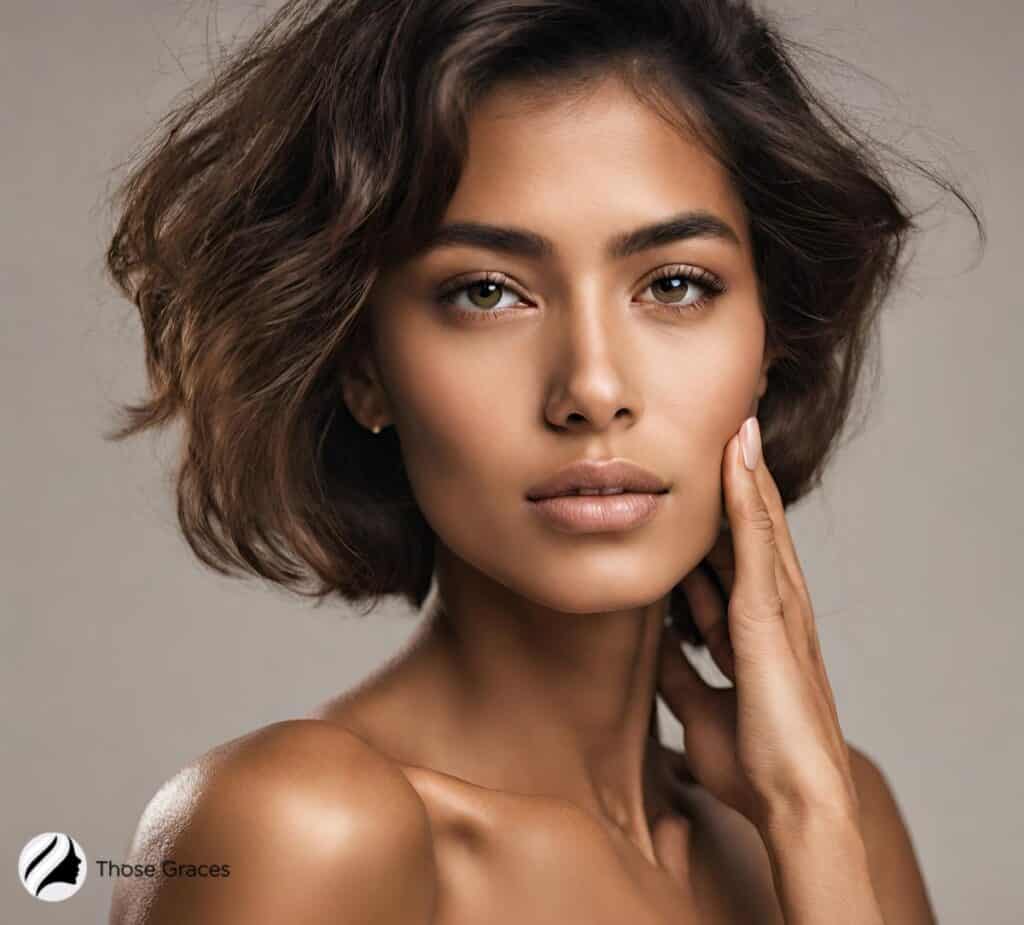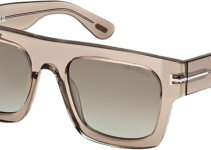Puzzled about whether a “best for olive skin tone” product exists? You’re in LUCK!
After a complete mental breakdown about my skin issues, I (now a beauty expert!) have learned the secret to lightening up my olive skin with a simple tool: the Fitzpatrick scale.
In this post, I’ll reveal a magical skincare recipe about olive skin, how to nourish it, which ethnicities pertain to which skin tone (yes, I’ll reveal it all!), and how to use the Fitzpatrick scale to turn your skin into a shiny crystal glow!
Let’s dive in together to learn all about the treasure of your lush olive skin ASAP!
FYI, this part of the post contains affiliate links. If you purchase through these links, we earn a small commission at no extra charge to you.
Table of Contents
Key Takeaways
- Understanding Olive Skin Tone: Olive skin has neutral undertones with a green-tinted pigment. Knowing your skin’s undertone is crucial for choosing the right beauty products, from foundation to eye shadow, ensuring a flattering match.
- Fitzpatrick Scale for Olive Skin: Olive skin falls under Types III, IV, and V on the Fitzpatrick Scale.
- Ethnic Variability and Care Tips: Olive skin is common among various ethnicities and requires specific care routines.
What to Know About Olive Skin Tone
Skin experts explain that an olive skin tone – often light brown – sits between dark and light skin tones. Besides, these neutral undertones radiate a plush, fashionable green-tinted pigment [2].

Knowing your skin type is vital to helping us make the best beauty purchases.
This is especially true if you’re shopping for foundation or concealer, but it also matters when choosing everything from eye shadow to blush.
Our skin’s complexion mainly depends on the undertones.
Like all skin colors, however, even olive skin can be broken down into sub-tones.
Are you sure that you’ve got that gracious olive tint?
Scroll on for the different types of olive skin tones to know which category you fall in…
FYI: Look at this are pulling off! olive skin tone celebrities.
How to Determine if You Have an Olive Skin Tone? The Verdict
If your skin shows a green or grey tinge, challenging warm or cool categories, you likely have olive skin, say experts at Beautylish. Pay attention to how specific colors complement or clash with your complexion [1].
It is easy for you to get confused between golden-tanned skin and olive-toned skin.
Most people think that they can achieve this coloring by laying out in the sun or using tanning products, but that’s not the case.
See, you determine what tone your skin takes on. More melanin equals darker skin, while less equals a paler shade. melanin levels
You just don’t get an olive skin tone; you have to be born with it. The difference between sun-tanned skin and true olive skin lies in the subtle greenish or yellowish tint.
Note the word “subtle.†The greenish and yellow tints blend with rich golden or tan shades to create a stunning tone.
So, how can you determine if you have an olive skin tone?
Here’s a way to determine if you have olive skin. You may not notice all of them, however. quick checklist
You have both warm and neutral undertones. Find the perfect color match for your unique Asian skin tone by checking out our article on the best clothing colors for Asian skin tones!
Now, let’s unlock the magic of the Fitzpatrick scale…
How Do I Know I Have an Olive Skin Tone By Using The Fitzpatrick Skin Type Scale?
Another way to determine your skin tone is to use the Fitzpatrick Scale, which classifies skin using a numerical catalog.
As a neutral share, the olive skin tone falls on the Fitzpatrick Scale in Type III, IV & V.
Use the Fitzpatrick Scale to Find the Right Foundation & Concealer
Have you ever tried to match foundation or concealer to your skin and noticed how tricky it could be? Below is a detailed description of each type of skin tone…
1. Type III Pigmentation
This skin type is characterized by pink to medium beige skin that tans easily.
People with type III pigmentation have a unique balance between the two different types of melanin, Eumelanin, and pheomelanin, that determine the skin and hair color.
This balance results in a wide variety of potential skin tones.
Type III pigmentation is a skin type that is less likely to burn to sun exposure than types I and II.
And even though this type of skin tone is moderately at risk of developing sun exposure-related diseases, it is still important to protect yourself from the sun.
Type III skin tone is frequently found in Latin America, the Mediterranean, and parts of Asia.
Does red hair for olive skin suit? Read this article to find out…
2. Type IV Pigmentation
Fitzpatrick skin type IV is for people with dark hair and a skin tone ranging from beige to moderate brown.
Colors for olive skin tone rarely burn and tan easily, thus making their risk of developing skin cancer less than skin type I to III. Skin IV olive tone is prone to an overactive production of melanin following certain skin rejuvenation procedures.
The skin tone is typical among people from the Mediterranean but is also frequent in Latin America and Asia.
3. Type V Pigmentation
People with type V pigmentation have skin tones that range from olive to tan. The skin does not burn easily and tans rather easily.
They are prone to developing skin cancer, but the risk is lower when compared to people with skin type 1 to 3. Skin type V has an olive or dark skin tone.
It is typical among people from the Indian subcontinent, parts of Africa, Latin America, the Middle East, and the Mediterranean.
Confused by all the Skin Color Names? Watch the video below!
Learn More About Olive Skin Tone Ethnicity
Which ethnicities have olive skin? Quite a few. Let’s take a look at the most common.
The Mediterranean
Olive skin tones are most common in people in countries lining the Mediterranean Sea. This includes parts of Southern Europe, Northern Africa, and Eastern Asia.
Some examples:
- Greece
- Italy
- Spain
- Turkey
- Egypt
- Tunisia
- Morocco
- Algeria
- Turkey
- and even parts of France
Middle East
Along with Middle Eastern nations along the Mediterranean, olive skin is common in Syria, Yemen, Kuwait, and UAE.
Latin America
Latin American countries where you will find people with olive skin tones include Paraguay, Colombia, Argentina, Costa Rica, Honduras, and Mexico.
Indian Subcontinent
The Indian subcontinent consists of people from areas like Pakistan, India, Sri Lanka, Bangladesh, and Nepal.
The Indians and Pakistanis typically share the olive tones of Type III and IV of the Fitzpatrick scale, while those in Bangladesh and Sri Lanka fall into Type V.
Get ready for some practical, super hip skincare tips in a heartbeat!
Recommended Skincare Tips for Olive Skin Tone
How should I take care of my skin if I have an olive complexion? If this is a question that is constantly running on your mind, then you are in the right place.

Below are some of the recommended tips to help you maintain the beauty of your skin.
1. Face Cleansing
No products found.As olive skin leans more towards oily than dry, you’ll want a that focuses on removing excess sebum (a fancy word for oil).
Using cleansers helps remove excess oil from your skin without causing it to dry out.
Choose a good foaming cleanser for your nighttime routine, then a very mild cleanser in the morning as a bit of a refresher.
Avoid using medicated cleansers (such as those with salicylic acid) unless your dermatologist tells you to do so.
DO NOT be tempted to use anti-acne face cleansers on oily skin as a preemptive strike against pimples. They can rather than prevent them. cause breakouts.
Some of the best face cleansers for olive skin tone include Neutrogena Fresh Foaming Cleanser, Dior Prestige Satin Revitalizing Eye Crème, and clay face masks.
No products found.
2. Dealing with Dark Spots & Unwanted Hair
No products found.The trick to getting rid of dark spots is to gently exfoliate by sloughing away dead skin.
You can also use a mild depilatory cream to get rid of unwanted facial hair as well as correct the dark spots.
To exfoliate, you need to apply cream like 2 Minute Miracle’s Gentle Exfoliating Gel or Daily Microfoliant after your skin cleansing routine.
Be careful as some methods are not gentle and might end up bruising or causing acne on your olive skin.
No products found.
Apply Moisturizer
No products found.To keep your olive skin glowing, you need to apply moisturizers that leave your olive skin feeling smooth and hydrated.
Apply a light, oil-free broad-spectrum moisturizer like Pure Radiant Tinted Moisturizer after washing in the morning to minimize skin dryness.
To know what colors look good on olive skin, check out this video!
Check: Best Makeup for Olive Skin Tone
What Are the Pros and Cons of Olive Skin Tone?
Just like the black, fair, or neutral skin tone have pros and cons, olive skin tone is no exception. It comes with specific advantages and disadvantages, like other skin colors.
Advantages
#1 Less Sensitive to the Sun
One of the main advantages of olive skin tone is that it’s not sensitive to sun radiations as compared to type 1 and 2 skin types.
The reason is because of the production of melanin, a natural pigment that gives skin its color.
It also absorbs UV radiation better than fair skin, offering a bit more protection from the sun’s harmful rays.
That said, DO NOT skimp on the sunscreen! Every single skin tone and color needs sunscreen.
#2 It is Not as Prone to Dryness
Olive skin tends to be oilier, and this protects the skin from harsh elements of the environment, like dryness and wrinkles.
The oiliness also helps the olive skin to appear thicker and smoother and gives a glowing and youthful appearance.
#3 Choice of Jewelry and Clothing
Another advantage is that you have the freedom to select any jewelry and dress color to wear, provided it suits your skin color complexion.
Disadvantages
#1 Pores clog easily
Oily skin can be good and also bad because too much of it clogs up the pores, thus resulting in pimples and acne.
This particularly affects adolescents during their hormonal changes.
Check: Best Primer for Acne Prone Skin
#2 Damage From Sun Exposure
And even though melanin protects the olive skin from harmful sun rays, it doesn’t leave the skin immune from damage caused by prolonged sun exposure.
Irritation can cause discoloring.
Once the skin is affected even by the slightest irritation, the skin tends to produce more melanin, putting it at risk of discoloration or getting blemishes.
Due to the thicker dermis and subcutis of olive skin, these fat layers give the appearance of jowls among older people.
#3 Uneven Skin Tone
Olive skin can sometimes have an uneven complexion, with patches of darker or lighter areas. This can be frustrating for individuals who desire a more uniform and radiant skin tone.
The unevenness of the skin tone can be caused by various factors, including sun exposure, hormonal changes, and genetics.
Now that you have understood the advantages and disadvantages of having an olive skin type let’s discuss ways of taking good care of it.
But can you acquire an olive skin tone? Keep digging…
Why is it Called Olive Skin? The Buzz About Olive Skin
Actually, the term “olive” aptly captures the essence of these unique undertones, mirroring the diversity found within actual olives, which vary widely in color.
It refers to a complexion that falls between light and dark, typically with yellow or green undertones.
The name “olive” accurately captures the diverse range of colors found within this skin tone category, just like olives themselves, which come in various shades of green and even brownish hues.
This understanding opens up a new perspective on olive skin, emphasizing its complexity and the importance of recognizing its true nature.
But can you acquire olive skin? Let’s find out…
Can you acquire an olive skin?
Sadly, olive skin (just as with any other skin tone) is largely determined by genetics and not something one can acquire through external means like sun exposure or skin care products.
This skin tone is inherited and is a characteristic feature of individuals from certain ethnic backgrounds.
Of course, while sun exposure can darken the skin temporarily, it does not alter the fundamental undertones that define olive skin.
Instead, to embrace and enhance your natural skin tone, focus on skincare and makeup choices that highlight your inherent beauty.
Now, get ready to tackle your burning questions…
FAQs
1. What is an Olive Skin Tone?
This unique blend gives the skin a natural, earthy glow that’s distinctive among various ethnicities.
2. Can You Have Pale Olive Skin?
People with pale olive skin may burn more easily than those with darker olive complexions but still possess that subtle, unique undertone.
3. What Makeup Shades Are Best For Olive Skin?
Instead, select foundations and concealers that match your skin’s unique undertone for a flawless finish.
Conclusion
Got an olive skin tone? Ok, then lady luck charmed you – for sure!
Besides, your skin is not sensitive to the sun and tans easily and nicely (unlike your green-with-envy pals who still struggle with sunburn and all those nasty skin gremlins…), so you’re good to go!
But…
Even though your skin is less sensitive, you must apply sunscreen to avoid skin damage.
Understanding your skin’s undertone will help you select the right colors to wear and the right makeup.
Now, before you leave, say Hi. Share any tips, tricks, hacks (or any fancy variants) with me ASAP. As always, I’d love to hear from my fellow olive-skin buddies!
Resources
1. Olive Skin: The Right Looks For Your Tone [Internet]. RMS Beauty. [cited 2024 Feb 11]. Available from: https://www.rmsbeauty.com/blogs/news/olive-skin
2. FREITAS-SEITZ K. How to Tell If You Have Olive Undertones [Internet]. Beautylish. 2019 [cited 2024 Feb 12]. Available from: https://www.beautylish.com/a/vzaxi/how-to-tell-if-you-have-olive-undertones
3. Ezekiel L. If you’ve got olive skin you NEED to read this… | EX1 Cosmetics [Internet]. ex1cosmetics.com. 2021. Available from: https://ex1cosmetics.com/blogs/liveolive/olive-skin-the-myths-and-the-facts



